How to re-enter people into a journey or playbook campaign
Overview
Sometimes, you may need to re-enter a person into a campaign after they've already started / left. This could be because you've added new messages or actions like record updates / notifications.
For more details on entry criteria with / without occurs conditions, see Using "occurs' in campaign entry criteria.
People can be in journey
If you are modifying a journey, you'll first need to set the People can be in journey setting to one of the following options:
- Only once, and enter multiple times.
- More than once, and enter multiple times.
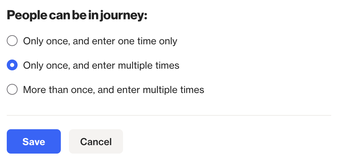
NOTE: By default, playbook campaigns allow a person to be in a playbook Once, and enter multiple times.
Review your entry criteria
You’ll need to take different approaches depending on whether or not your entry criteria is using occurs conditions.
Entry criteria with an "occurs" condition
If the entry criteria contains an occurs condition, then the person can only re-enter the journey/playbook when they perform the activity again.
NOTE: When you perform a backfill of activities for connected data sources, activities older than 6 hours will not quality for occurs conditions.
Example scenarios based on the entry criteria New trial occurs:
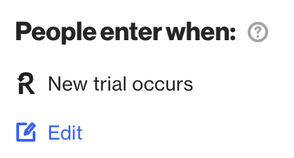
- If the entry criteria remain unchanged and a person performs the activity again, they will re-enter the journey (if your People can be in journey setting allows it).
- If you modify the entry criteria (like adding a new condition), the person will not re-enter unless they perform the activity again. This rule applies whether the journey is switched OFF and back ON or stays ON.
- If the journey is switched OFF and then ON again, the person will only re-enter if they perform the activity again.
Entry criteria without an "occurs" condition
If the entry criteria is based on a field value or a has occurred condition, changing the criteria or turning a campaign ON/OFF will affect people in different ways.
Check the scenarios below to see which option works best for your needs.
Modify the entry criteria while the journey/playbook is switched ON
- This approach is ideal when you need people who no longer meet the entry criteria to re-enter the campaign.
EX: Using the New trial has occurred in the last 14 days example above, this approach is suitable for people who started a trial more than 14 days ago.
To make this happen, you can apply a tag to the contacts who need to re-enter the campaign, and then update the entry criteria to include the tag. Here’s how:
- Add a tag (e.g. Re-enter onboarding series) to the people you want to re-enter.
- Update the campaign’s entry criteria by adding the condition Tag is with the relevant tag (e.g. Tag is Re-enter onboarding series).
- Save your changes.
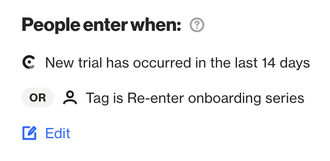
- This approach will check which contacts are eligible to enter the campaign. It will trigger new entries for people who match New trial has occurred in the last 14 days and re-enter people who match Tag is Re-enter onboarding series.
Switch the campaign OFF and back ON
- This approach works best when you have people who still meet the entry criteria but need to re-enter the campaign. For example, using the New trial has occurred in the last 14 days example above, this would be suitable for people who started a trial within the last 14 days.
- Switching the campaign OFF/ON will re-evaluate everyone who meets the entry criteria, causing them to enter (or re-enter) the campaign. This is generally best for re-entering a single batch of people.
- If you need to re-enter another group later, you’ll need to repeat this OFF/ON process to re-evaluate who enters.
NOTE: Be mindful that if entry criteria includes a date range, some people may no longer meet the date requirements. In this case, it may be more beneficial to modify the entry criteria while the campaign still ON - refer to Modify the entry criteria while the journey/playbook is switched ON for further guidance.
TIP: If you choose to modify your entry criteria to re-enter people into a journey, consider how different condition types and AND/OR operators will affect the journey audience.
Limitations on using "occurs"
An occurs condition on its own will only enter new people into the journey when they perform the activity. It will not re-enter people unless those people perform the activity again.

Occurs conditions can only be used with the operator OR (not AND), so you may want to consider how that affects your journey audience if you want to add more than 1 condition to the entry criteria.
Using AND/OR in the entry criteria
If you take the approach of adding tags to people you want to re-enter, and adding a Tag is X condition to the entry criteria, be careful when setting the AND/OR condition.
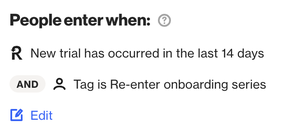
- In the screenshot above, using the AND operator will only re-enter people who have had a new trial in the last 14 days and have the specified tag. It will not re-enter people who have the tag but have not started a trial in the last 14 days.
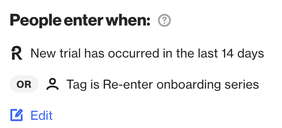
- In the screenshot above, using the OR operator will re-enter people who started a new trial in the last 14 days, and people who have not had a new trial in the past 14 days, but who do have the specified tag.
Managing messages already received
Once your journey settings are updated, you will need to decide if people who re-enter the journey should receive messages they've already received.
EX: If your journey has 2 email messages and you add a 3rd one, you can control whether people receive the initial 2 emails again. In the email shape settings, you can determine whether each email can be received once or multiple times.
You can do this by:
- In the journey editor, click the more icon (...) on the email shape > select View.
- Under People can receive this message, set the option to to Only once or More than once.
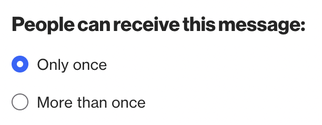
NOTE:
- The Only once option has different time limitations for email and SMS:
- Email: If the message was sent in the last 30 days, it will not resend. However, if it was last sent more than 30 days ago, it will resend, even if the person has already received it.
- SMS: If the message was sent in the last 7 days, it will not resend. However, if it was last sent more than 7 days ago, it will resend, even if the person has already received it.
- The Only once option applies to a person's email address across all records in your CDP. As such, if there are duplicate records with the same email address, the subsequent duplicate records will receive an Invalid email activity for this email message.
Managing actions already performed
Along with managing messages already received, you may want to decide if any actions from the first journey entry should be repeated when someone re-enters.
EX: If there is an action to create a Salesforce record when someone meets a condition, you likely don’t want another record created when they re-enter. In this case, you can set the action to happen only once.
Here’s how you can do this:
- In the journey editor, click the more icon (...) on the action shape > View.
- Under This action can occur, make sure it's set to Only once. If not, click Edit to update and save.
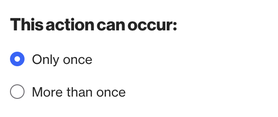
NOTE:
- This approach applies to all system and data source actions.
- The Only once option applies to a person's email address across all records in your CDP (meaning for duplicate records with the same email, the action can occur only once for one record).
